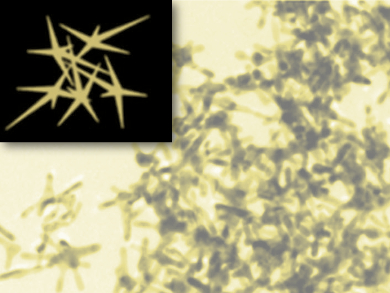The significant increase in the use (and misuse) of antibiotics allows microbes to evolve into antibiotic-resistant strains. Drug-resistant bacteria have become a major health threat: In the EU alone, there are 400,000 patients a year suffering from antibiotic-resistant infections. One multidrug-resistant superbug is Pseudomonas aeruginosa, which causes various types of infections. It is often embedded within a self-produced biofilm, where bacteria are well protected and are extremely resistant to any antibiotic treatment.
Khin Yin Win and Ming-Yong Han, A*STAR, Singapore, Lianhui Zhang, National University of Singapore, and colleagues developed an alternative photothermal treatment for drug-resistant infections. The team conjugated gold nanocrosses to antibodies, which bind to their specific surface antigens on the infectious bacteria. Here the antibodies target a secretion protein of P. aeruginosa. The antibodies on the nanocrosses bind to surface antigens on the infectious bacteria. The anisotropically branched nanocrosses (pictured) exhibit a strong near-infrared (NIR) absorption and hence generate heat quickly upon irradiation.
NIR-irradiation for five minutes at a power density of 3.0 W/cm2 was sufficient to destroy the bacteria as well as their biofilms. According to the researchers, the approach can be easily shifted to target other bacteria by simply exchanging the antibodies.
- Effective Targeted Photothermal Ablation of Multidrug Resistant Bacteria and Their Biofilms with NIR-Absorbing Gold Nanocrosses,
Choon Peng Teng, Tielin Zhou, Enyi Ye, Shuhua Liu, Leng Duei Koh, Michelle Low, Xian Jun Loh, Khin Yin Win, Lianhui Zhang, Ming-Yong Han,
Adv. Healthcare Mater. 2016.
DOI: 10.1002/adhm.201600346




